Draft EA - San Diego International Airport
Draft EA - San Diego International Airport
Draft EA - San Diego International Airport
Create successful ePaper yourself
Turn your PDF publications into a flip-book with our unique Google optimized e-Paper software.
14 CFR Part 150 Update August 2009<br />
<strong>San</strong> <strong>Diego</strong> <strong>International</strong> <strong>Airport</strong> Page 48<br />
5.2.3 Aircraft noise and performance characteristics<br />
Specific noise and performance data must be entered for each aircraft type operating at the airport.<br />
Noise data is included in the form of sound exposure level (SEL – see Appendix B) at a range of<br />
distances (from 200 feet to 25,000 feet) from a particular aircraft with engines at a specific thrust<br />
level. Performance data includes thrust, speed and altitude profiles for takeoff and landing<br />
operations. The INM database contains standard noise and performance data for over one hundred<br />
different fixed wing aircraft types, most of which are civilian aircraft. The program automatically<br />
accesses the applicable noise and performance data for departure and approach operations by those<br />
aircraft.<br />
This study included many different aircraft types. While many aircraft could be modeled by direct<br />
assignments from the standard INM database, many were not in the INM database. For those aircraft<br />
types not in the INM standard database, FAA approved substitutions were used to model the aircraft<br />
with a similar type that was in the database, or a user-defined aircraft was created for that specific<br />
aircraft type. FAA approved substitutions came from the following three sources:<br />
■<br />
■<br />
■<br />
INM Version 7.0a includes the current list of standard FAA substitutions;<br />
SAN Part 150 specific request to the FAA for non-standard substitutions and user-defined<br />
aircraft (request and FAA approval documented in Appendices C, D, and E);<br />
INM 5.0 User’s Guide for pre-approved user defined aircraft, specifically three-engine business<br />
jets.<br />
5.2.4 Runway utilization<br />
The SAN operations database contains a record of each flight detected by passive radar and collected<br />
and retained by ANOM. Each record in the database contains the date and time of flight and the<br />
runway used. From these records, overall runway usage tables for 2009 and 2014 were compiled by<br />
arrival or departure, day or night, and aircraft type. Table 8 presents the runway utilization rates that<br />
HMMH developed for this study.<br />
Table 8 Runway Utilization<br />
Source: ANOMS, HMMH<br />
Runway Use<br />
Runway<br />
Arrivals<br />
Departures<br />
Day Evening Night Day Evening Night<br />
Runway 09 1.36% 1.24% 4.73% .94% 1.13% 0.86%<br />
Runway 27 98.64% 98.76% 95.27% 99.06% 98.87% 99.14%<br />
Total 100% 100% 100% 100% 100% 100%<br />
5.2.5 Flight track geometry<br />
As discussed earlier, RealContours provides increased precision in modeling INM flight tracks.<br />
RealContours uses individual flight tracks taken directly from radar systems rather than relying on<br />
consolidated, representative flight tracks data. This provides the advantage of modeling each aircraft<br />
operation on the specific runway it actually used and at the actual time of day of the arrival or<br />
departure. RealContours then sets up an INM study for each day using INM standard data. Each<br />
day is then modeled in the INM and the results for each day combined and averaged to get the annual<br />
contour.<br />
SAN DIEGO COUNTY REGIONAL AIRPORT AUTHORITY
















